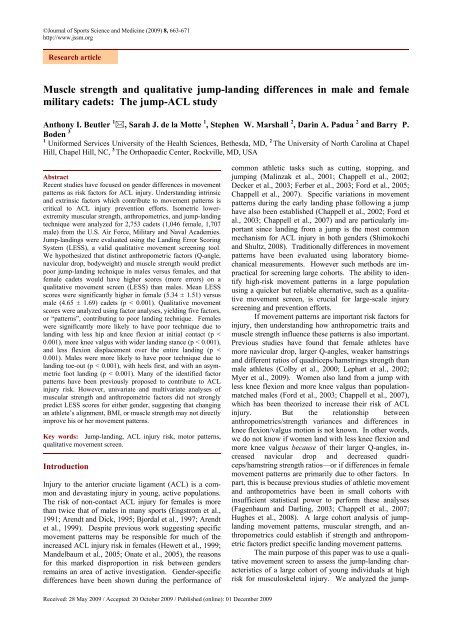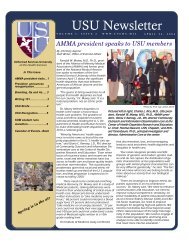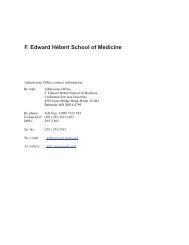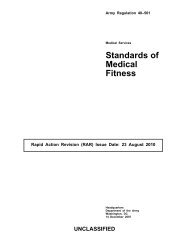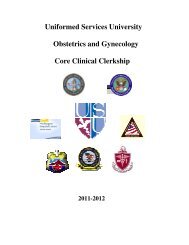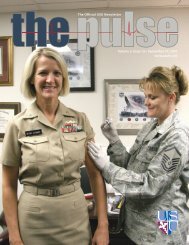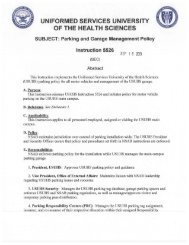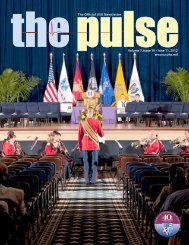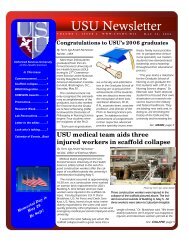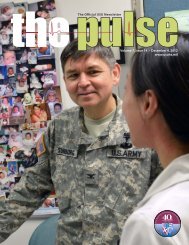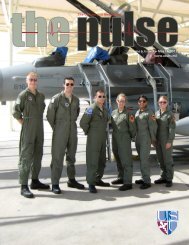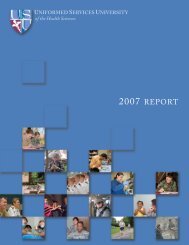Muscle strength and qualitative jump-landing differences in male ...
Muscle strength and qualitative jump-landing differences in male ...
Muscle strength and qualitative jump-landing differences in male ...
Create successful ePaper yourself
Turn your PDF publications into a flip-book with our unique Google optimized e-Paper software.
Beutler et al. 665Figure 1. Jump-L<strong>and</strong><strong>in</strong>g Task: Participants <strong>jump</strong>ed from a 30cm high box onto a forceplate <strong>and</strong> then immediatelyrebounded back up <strong>in</strong> a maximal <strong>jump</strong>.the required horizontal distance or did not vertically <strong>jump</strong>after the <strong>in</strong>itial l<strong>and</strong><strong>in</strong>g, that trial was discarded <strong>and</strong> the<strong>jump</strong>-l<strong>and</strong><strong>in</strong>g manoeuvre repeated.Two tripod-mounted digital camcorders recordeda frontal <strong>and</strong> sagittal view of each <strong>jump</strong>, at a distance of16 <strong>and</strong> 13 feet, respectively. Cameras were levelled us<strong>in</strong>gthe built-<strong>in</strong> level on each tripod. All <strong>jump</strong>-l<strong>and</strong><strong>in</strong>g videoswere analyzed at a later time by tra<strong>in</strong>ed raters us<strong>in</strong>g theL<strong>and</strong><strong>in</strong>g Error Scor<strong>in</strong>g System (LESS) (Bol<strong>in</strong>g et al.,2005; DiStefano et al., 2009; Padua et al., 2009). TheLESS is a cl<strong>in</strong>ical assessment tool that reliably identifies<strong>in</strong>dividuals with potentially high-risk biomechanics(Padua et al., 2009). Jump-l<strong>and</strong><strong>in</strong>g quality is assessed byanalyz<strong>in</strong>g videotapes of the <strong>jump</strong>-l<strong>and</strong><strong>in</strong>g task <strong>in</strong> the sagittal<strong>and</strong> frontal planes. Scor<strong>in</strong>g is based on the presenceor absence of specific l<strong>and</strong><strong>in</strong>g characteristics as described<strong>in</strong> the Appendix. Individually scored items are totalled tocreate an overall LESS score (range 0-17), with higherscores (more errors) <strong>in</strong>dicative of higher-risk l<strong>and</strong><strong>in</strong>gtechnique. Overall LESS scores were averaged over threevalid <strong>jump</strong> trials for analyses.Data analysisIndependent t-tests were used to compare gender me<strong>and</strong>ifferences for subject anthropometrics, <strong>strength</strong> values,<strong>and</strong> overall LESS score. Separate univariate <strong>and</strong> multivariatel<strong>in</strong>ear regressions were used to determ<strong>in</strong>e thepredictive validity of subjects’ anthropometrics <strong>and</strong> muscle<strong>strength</strong> us<strong>in</strong>g overall LESS score as the dependentvariable. Individual models for <strong>male</strong>s <strong>and</strong> fe<strong>male</strong>s werefit so as to assess gender-specific relationships.Additionally, factor analysis was performed on <strong>in</strong>dividualLESS items to identify <strong>in</strong>ter-related movementerrors [For factor analysis, a positive score on <strong>in</strong>dividual LESSitems was def<strong>in</strong>ed as an Error if was judged to occur on at least2 of 3 trials (items 1-15)]. We used varimax rotation <strong>and</strong>iterated analyses. Two “general purpose” items on theLESS (#16 <strong>and</strong> #17) were excluded from analysis becauseof possible coll<strong>in</strong>earity with the other 15 items. Regressiondiagnostics <strong>in</strong>dicated no coll<strong>in</strong>earity <strong>in</strong> the rema<strong>in</strong><strong>in</strong>gLESS items (largest condition <strong>in</strong>dex of 4.6). Pooled variancet-tests were used to compare factor means betweengenders as well as factor frequency by gender. The significancelevel for all analyses was set a priori at α = 0.05.ResultsL<strong>and</strong><strong>in</strong>g technique: the L<strong>and</strong><strong>in</strong>g Error Scor<strong>in</strong>g System(LESS)Total overall L<strong>and</strong><strong>in</strong>g Error Scor<strong>in</strong>g System (LESS)scores were significantly different (p < 0.001) for <strong>male</strong>s<strong>and</strong> fe<strong>male</strong>s. Males’ mean score was 4.65 ± 1.69 (Range0.00-10.67). The mean score for fe<strong>male</strong>s was 5.34 ±1.51(range 0.33-11.00).Factor analysis is a statistical method used to detectstructure <strong>in</strong> the relationships between variables, or <strong>in</strong>other words, identify patterns among the observed variables.Us<strong>in</strong>g data from <strong>in</strong>dividual LESS items, factoranalyses revealed five groups of related errors (orthogonalfactors): Factor 1 - decreased sagittal trunk, hip <strong>and</strong> kneeflexion at <strong>in</strong>itial ground contact (LESS Items L3, L2,<strong>and</strong>L1); Factor 2 - valgus knee <strong>and</strong> feet wide at <strong>in</strong>itial contact(Items L5 ,L15, <strong>and</strong> L7); Factor 3 - toes out <strong>and</strong> kneesflexed at <strong>in</strong>itial contact (Items L10 <strong>and</strong> L1); Factor 4 -heelstrike l<strong>and</strong><strong>in</strong>g <strong>and</strong> asymmetric footstrike l<strong>and</strong><strong>in</strong>g;(Items L4 <strong>and</strong> L11) <strong>and</strong> Factor 5 - less sagittal flexionover the l<strong>and</strong><strong>in</strong>g phase (Items L12, L13, <strong>and</strong> L14). Thesefive factors all had Eigenvalues greater than one, <strong>and</strong>collectively accounted for 67% of the covariance betweenthe 15 LESS items.Pooled variance t-tests between genders on these 5 factorsshowed that fe<strong>male</strong>s were significantly more likely than<strong>male</strong>s to l<strong>and</strong> with: less hip <strong>and</strong> knee flexion at <strong>in</strong>itialcontact (Factor 1, p < 0.001); more knee valgus <strong>and</strong> widerl<strong>and</strong><strong>in</strong>g stance (Factor 2, p < 0.001); <strong>and</strong> less flexiondisplacement over the entire l<strong>and</strong><strong>in</strong>g phase (Factor5, p
666<strong>Muscle</strong> <strong>strength</strong> <strong>and</strong> movement pattern <strong>differences</strong>Table 2. Number of subjects scor<strong>in</strong>g an error for each factor 1,2 .Male(N=1707)Fe<strong>male</strong>(N=1046)Factor N % N %Factor 1 Poor Sagittal Flexion – Stance 559 32.8% 448 42.6%Factor 2 Valgus Knee & Feet Too Wide 428 25.1% 386 36.7%Factor 3 Toes Out & Knees Flexed 503 29.5% 154 14.6%Factor 4 Heelstrike & Uneven Footstrike 751 44.1% 273 26.0%Factor 5 Poor Sagittal Flexion – L<strong>and</strong><strong>in</strong>g 582 34.1% 472 44.9%1 Factors generated from factor analysis load<strong>in</strong>g. 2 For items 1-15, a positive score was def<strong>in</strong>ed as an Error onat least 2 of 3 trials. For items 16 & 17, a positive score was def<strong>in</strong>ed as Average on at least 2 of 3 trials orPoor/ Stiff on at least 1 of 3 trials.showed that <strong>male</strong>s <strong>and</strong> fe<strong>male</strong>s were significantly differentfor all <strong>in</strong>vestigated anthropometric (height, weight,BMI, navicular drop, <strong>and</strong> Q-angle) <strong>and</strong> <strong>strength</strong> variables(Tables 3 <strong>and</strong> 4).Table 3. Subject biometrics. Data are means (±SD).Males(n = 1,607)Fe<strong>male</strong>s(n = 994)Height (m) 1.78 (.07) 1.66 (.07) *Weight (kg) 77.4 (12.3) 63.0 (7.8) *Body Mass Index 24.3 (3.1) 22.9 (2.3) *Navicular Drop (mm) 7.5 (2.8) 7.0 (2.6) *Q-Angle (º) 8.6 (4.5) 11.6 (4.9) ** p < 0.001Table 4. <strong>Muscle</strong> <strong>strength</strong> normalized to body mass (N·kg -1 ).Data are means (±SD).Males(n = 1,607)Fe<strong>male</strong>s(n = 994)Quadriceps .49 (.09) .41 (.09) *Hamstr<strong>in</strong>gs .24 (.05) .21 (.05) *Hip external rotation .21 (.04) .17 (.03) *Hip <strong>in</strong>ternal rotation .19 (.04) .18 (.04) *Gluteus maximus .26 (.07) .23 (.07) *Gluteus m<strong>in</strong>imus .34 (.08) .30 (.07) ** p < 0.001Predict<strong>in</strong>g poor l<strong>and</strong><strong>in</strong>gDue to miss<strong>in</strong>g data values, univariate <strong>and</strong> multivariateregression models were analyzed for 2,734 participants(fe<strong>male</strong>s = 1046; <strong>male</strong>s = 1688). Univariate analysis for<strong>male</strong>s <strong>in</strong>dicated that low BMI, <strong>in</strong>creased Q-angle, <strong>and</strong>poor gluteus medius <strong>strength</strong> were <strong>in</strong>dividually predictiveof poor l<strong>and</strong><strong>in</strong>g technique (higher LESS score). Howeveras a group, multivariate modell<strong>in</strong>g showed extremelylimited predictive value (comb<strong>in</strong>ed R 2 =.016; p < 0.01)<strong>and</strong> only lower BMI <strong>and</strong> weak hip <strong>in</strong>ternal rotation<strong>strength</strong> significantly contributed to poorer l<strong>and</strong><strong>in</strong>g technique(Table 5). For fe<strong>male</strong>s, univariate analyses suggestedthat weaker hamstr<strong>in</strong>gs <strong>and</strong> weaker gluteus medius<strong>strength</strong> were important predictors of poorer <strong>jump</strong>-l<strong>and</strong><strong>in</strong>g(Table 6). However, <strong>in</strong> contrast to <strong>male</strong>s, we were notable to strongly predict specific contributors to l<strong>and</strong><strong>in</strong>gerror <strong>in</strong> fe<strong>male</strong>s with multivariate analysis (p = 0.098).Aga<strong>in</strong>, the predictive value of all these variables as agroup was very limited (comb<strong>in</strong>ed R 2 = 0.014).DiscussionMovement pattern <strong>differences</strong> can be assessed by theLESSThe ability to quickly <strong>and</strong> reliably identify <strong>in</strong>dividuals athigh risk of <strong>in</strong>jury is critical to <strong>in</strong>jury prevention efforts.Because high-risk movement patterns have been l<strong>in</strong>ked toACL <strong>in</strong>jury risk (Hewett et al., 2005; Krosshaug et al.,2007), the ability to rapidly screen for these movementpatterns could facilitate the implementation of large-scale<strong>in</strong>jury prevention efforts. Our results <strong>in</strong>dicate that a <strong>qualitative</strong>movement screen, the L<strong>and</strong><strong>in</strong>g Error Scor<strong>in</strong>g System(LESS) can accurately characterize the <strong>jump</strong>-l<strong>and</strong><strong>in</strong>gcharacteristics of a large cohort of <strong>male</strong>s <strong>and</strong> fe<strong>male</strong>s.Fe<strong>male</strong>s demonstrated poorer overall l<strong>and</strong><strong>in</strong>g technique(5.34 ± 1.51 vs. 4.65 ± 1.69 for <strong>male</strong>s) <strong>and</strong> showed lessknee flexion, less hip flexion <strong>and</strong> more valgus collapse.These results are similar to studies of common movementtasks us<strong>in</strong>g traditional laboratory biomechanics (Chappellet al., 2002; Hewett et al., 2006; Mal<strong>in</strong>zak et al., 2001;Padua et al., 2009). Previous work has shown that LESSscore is correlated with high-risk movement patterns asmeasured by traditional motion analysis (Padua et al.,2009). Taken together these results suggest that the LESSaccurately characterizes <strong>jump</strong>-l<strong>and</strong><strong>in</strong>g movements. Theresults of the present <strong>in</strong>vestigation do not allow us todeterm<strong>in</strong>e which <strong>differences</strong> are specifically correlatedTable 5. Univariate <strong>and</strong> multivariate regression results – Males.Univariate 1 Multivariate 1Variable β SE t-value p-value β SE t-value p-valueBMI -.091 .321 -3.77
Beutler et al. 667Table 6. Univariate <strong>and</strong> multivariate regression results – Fe<strong>male</strong>s.Univariate 1 Multivariate 1Variable β SE t-value p-value β SE t-value p-valueBMI -.024 .020 -.77 .44 -.040 .022 -1.22 .22Q-Angle .026 .010 .85 .40 .020 .010 .64 .52Navicular Drop -.017 .018 -.57 .57 -.020 .018 -.65 .52Quadriceps -.011 .554 -.36 .72 .045 .722 1.11 .29Hip Ext. Rotators -.023 1.426 -.73 .47 .041 1.931 .97 .33Hip Int. Rotators -.052 1.264 -1.70 .09 -.026 1.822 -.58 .57Hamstr<strong>in</strong>gs -.067 1.008 -2.17 .03 * -.070 1.387 -1.65 .10Gluteus Maximus -.005 .717 -.18 .86 .031 .786 .91 .37Gluteus Medius -.081 .646 -2.6 .01 -.094 .847 -2.32 .02 ** Statistically significant. 1 Univariate betas are not adjusted for any other variable; multivariate betas are adjusted forany other variables listed <strong>in</strong> the table.with an <strong>in</strong>creased risk of <strong>in</strong>jury. The error of measurementfor the LESS score is greater than observed gender <strong>differences</strong>,suggest<strong>in</strong>g that <strong>in</strong>dividual variability may limit thepredictive capacity of the LESS. However, the ability ofthe LESS to predict <strong>in</strong>jury <strong>in</strong> the military academy populationis an area of ongo<strong>in</strong>g study.Implications for <strong>in</strong>jury risk based on L<strong>and</strong><strong>in</strong>g ErrorPatternsWhile s<strong>in</strong>gular aspects of <strong>jump</strong>-l<strong>and</strong><strong>in</strong>g technique contributeto high-risk l<strong>and</strong><strong>in</strong>gs, it is possible that a comb<strong>in</strong>ationof multiple factors is more predictive of overall risk.We were able to determ<strong>in</strong>e common l<strong>and</strong><strong>in</strong>g-error patternsfor fe<strong>male</strong>s <strong>and</strong> <strong>male</strong>s us<strong>in</strong>g factor analysis. Strik<strong>in</strong>gly,each error pattern detected has been suggested <strong>in</strong>previous literature to contribute to ACL <strong>in</strong>jury: 1) decreasedsagittal flexion at <strong>in</strong>itial ground contact (Chappellet al., 2007); 2) valgus knee (Ford et al., 2003; Hewett etal., 1999; 2005) <strong>and</strong> feet wide at <strong>in</strong>itial contact; 3) toesout <strong>and</strong> knees flexed at <strong>in</strong>itial contact (DiStefano et al.,2009); 4) heelstrike l<strong>and</strong><strong>in</strong>g <strong>and</strong> asymmetric footstrikel<strong>and</strong><strong>in</strong>g (Boden et al., 2009); <strong>and</strong> 5) lack of sagittal flexionover the l<strong>and</strong><strong>in</strong>g (Chappell et al., 2007). While both<strong>male</strong> <strong>and</strong> fe<strong>male</strong> cadets exhibited these comb<strong>in</strong>ations ofhigh-risk movement, clear gender tendencies towardsdifferent patterns were detected (Table 2). Similar toprevious reports, 42.6% of fe<strong>male</strong>s <strong>in</strong> our cohort exhibitedshallow sagittal flexion angles (trunk, hip, <strong>and</strong> knee) atground contact (Factor 1) <strong>and</strong> 44.9% demonstrated poorknee flexion displacement over the entire l<strong>and</strong><strong>in</strong>g phase(Factor 5). These flexion faults <strong>and</strong> propensity towardsvalgus dur<strong>in</strong>g l<strong>and</strong><strong>in</strong>g are consistent with many prior<strong>in</strong>vestigations (Chappell et al., 2002; 2007; Colby et al.,2000; Mal<strong>in</strong>zak et al., 2001). In contrast to these f<strong>in</strong>d<strong>in</strong>gs,a recent study reported fe<strong>male</strong>s had <strong>in</strong>creased knee flexionat the time of ACL <strong>in</strong>jury versus <strong>male</strong>s (Krosshaug etal., 2007). However, knee <strong>and</strong> hip flexion may be taskdependent,which may expla<strong>in</strong> the differ<strong>in</strong>g results.We also found that fe<strong>male</strong>s were more likely than<strong>male</strong>s to l<strong>and</strong> with an excessively wide stance <strong>in</strong> comb<strong>in</strong>ationwith knee valgus (Factor 2). This has not beenpreviously reported <strong>in</strong> traditional biomechanical <strong>in</strong>vestigations.This wider l<strong>and</strong><strong>in</strong>g stance may represent an adaptiveprecursor to subsequent valgus collapse, or it maysimply reflect a wider average pelvic width <strong>in</strong> fe<strong>male</strong>cadets. We are directly measur<strong>in</strong>g pelvic width <strong>in</strong> anongo<strong>in</strong>g study. Analysis of that data may allow us tobetter describe the phenomenon of wide l<strong>and</strong><strong>in</strong>g stance <strong>in</strong>fe<strong>male</strong>s.Males exhibited different l<strong>and</strong><strong>in</strong>g-error patternsthan fe<strong>male</strong>s. The most common <strong>male</strong> factor was heelstrikel<strong>and</strong><strong>in</strong>g/uneven footstrike dur<strong>in</strong>g l<strong>and</strong><strong>in</strong>g (Factor 4),which occurred <strong>in</strong> 44.1% of our <strong>male</strong> population. Maleswere also more likely than fe<strong>male</strong>s to l<strong>and</strong> with “toes-out”(tibial external rotation) (Factor 3). These <strong>male</strong> errorpatterns have only recently been reported (Boden et al.,2009; Krosshaug et al., 2007) <strong>and</strong> are less familiar, perhapsless understood than fe<strong>male</strong> themes. While cadaveric<strong>and</strong> biomechanical modell<strong>in</strong>g studies suggest that ACLstra<strong>in</strong> is greater with knee <strong>in</strong>ternal rotation, analyses ofactual <strong>in</strong>jury mechanism describe an external rotatoryforce on the knee, suggest<strong>in</strong>g this position is <strong>in</strong>deed highrisk(Shimokochi <strong>and</strong> Shultz, 2008). The effects ofasymmetric foot strike <strong>and</strong> a heels-first l<strong>and</strong><strong>in</strong>g are lessdiscussed <strong>in</strong> ACL <strong>in</strong>jury literature. One possible implicationcomes from prelim<strong>in</strong>ary work by Boden <strong>and</strong> colleagueswho propose that a flat-foot l<strong>and</strong><strong>in</strong>g reduces theability of the calf muscles to dampen the ground reactionforces before they reach the knee (Shimokochi <strong>and</strong>Shultz, 2008).Predict<strong>in</strong>g poor l<strong>and</strong><strong>in</strong>gIn addition to classify<strong>in</strong>g common patterns of movement,we attempted to identify relationships between measuredanthropometric <strong>and</strong> <strong>strength</strong> elements <strong>and</strong> observed l<strong>and</strong><strong>in</strong>gmovement patterns. In the univariate analysis of <strong>in</strong>dividualvariables, our results suggest that low BMI contributesmore to <strong>jump</strong>-l<strong>and</strong><strong>in</strong>g movements <strong>in</strong> <strong>male</strong> cadetsthan <strong>in</strong> fe<strong>male</strong> cadets. The relationship between this f<strong>in</strong>d<strong>in</strong>g<strong>and</strong> previous reports of higher BMI be<strong>in</strong>g associatedwith <strong>in</strong>creased <strong>in</strong>jury <strong>in</strong> military <strong>and</strong> other populations isunclear (Jones et al., 1986; Knapik et al., 1991; Uhorchaket al., 2003). One possible explanation is that fatiguecould preferentially worsen movement patterns <strong>in</strong> thosewith high BMI. Future studies compar<strong>in</strong>g movementpatterns under fatigued <strong>and</strong> non-fatigued conditionswould facilitate further analysis. We also found that hiprotator <strong>strength</strong> exerts m<strong>in</strong>imal <strong>in</strong>fluence on poor l<strong>and</strong><strong>in</strong>gtechnique <strong>in</strong> either gender. This appears to contrast withrecent th<strong>in</strong>k<strong>in</strong>g <strong>in</strong> <strong>in</strong>jury prevention <strong>and</strong> rehabilitationwhere <strong>strength</strong>en<strong>in</strong>g hip rotators is thought to reduce<strong>in</strong>jury susceptibility (Hewett et al., 1999; M<strong>and</strong>elbaum etal., 2005). Our pend<strong>in</strong>g analysis of traditional biomechanicalmeasures dur<strong>in</strong>g the <strong>jump</strong>-l<strong>and</strong><strong>in</strong>g task may helpexpla<strong>in</strong> these apparently contradictory results.
668<strong>Muscle</strong> <strong>strength</strong> <strong>and</strong> movement pattern <strong>differences</strong>Most importantly, our results clearly demonstratethat muscle <strong>strength</strong> <strong>and</strong> anthropometric factors do NOTcontribute significantly to l<strong>and</strong><strong>in</strong>g movement patterns asmeasured by the LESS. Multivariate analysis showed verylittle contribution from anthropometric <strong>and</strong> <strong>strength</strong> valuesto overall movement patterns (R 2 = 0.016 for <strong>male</strong>s,0.014 for fe<strong>male</strong>s). This is a novel f<strong>in</strong>d<strong>in</strong>g. The primarytenants of many ACL <strong>in</strong>jury prevention programs averthat <strong>in</strong>creased lower extremity muscular will translate toimproved movement patterns dur<strong>in</strong>g athletic manoeuvres.In contrast, our f<strong>in</strong>d<strong>in</strong>gs suggest that simply chang<strong>in</strong>g anathlete’s alignment, BMI, or muscle <strong>strength</strong> may notultimately improve his or her movement patterns. Rather,l<strong>and</strong><strong>in</strong>g movements seem to be primarily determ<strong>in</strong>ed bycharacteristics other than <strong>strength</strong>, alignment, or bodymass. Future <strong>in</strong>vestigations should verify this lack ofcorrelation us<strong>in</strong>g traditional biomechanical methods. Ifconfirmed, the absence of a correlation <strong>in</strong> anthropometrics<strong>and</strong> muscle <strong>strength</strong> with an <strong>in</strong>dividual’s movement patternwould necessitate a paradigm shift <strong>in</strong> future <strong>in</strong>juryprevention <strong>in</strong>tervention design.Study limitationsWe caution that the use of a military population may limitthe generalizability of these results to all populations ofyoung athletes. Specifically, the overall athleticism, BMI,or fitness of the military academy population may besignificantly different than that of other populations. Additionally,although we have measured l<strong>and</strong><strong>in</strong>g movementpatterns <strong>in</strong> terms of “errors”—a common practice <strong>in</strong><strong>qualitative</strong> movement screen<strong>in</strong>g—we recognize that <strong>differences</strong><strong>in</strong> movement patterns cannot def<strong>in</strong>itively beclassified as errant unless prospectively l<strong>in</strong>ked to <strong>in</strong>juryrisk.ConclusionMale <strong>and</strong> fe<strong>male</strong> military cadets have <strong>differences</strong> <strong>in</strong> <strong>jump</strong>l<strong>and</strong><strong>in</strong>gtechnique as assessed through a <strong>qualitative</strong>movement screen. Fe<strong>male</strong>s demonstrate dist<strong>in</strong>ct l<strong>and</strong><strong>in</strong>gmovement patterns versus <strong>male</strong>s. L<strong>and</strong><strong>in</strong>g-error patternsmore common <strong>in</strong> <strong>male</strong>s <strong>and</strong> those more common <strong>in</strong> fe<strong>male</strong>sconta<strong>in</strong> features that have been previously postulatedto <strong>in</strong>crease ACL <strong>in</strong>jury risk. Most importantly, BMI,navicular drop, Q-angle, <strong>and</strong> muscular <strong>strength</strong> do notsignificantly predict movement patterns <strong>in</strong> either <strong>male</strong> orfe<strong>male</strong> cadets. We are collect<strong>in</strong>g ACL <strong>in</strong>jury <strong>in</strong>cidencedata from this cohort over their 4-year academy careers.This <strong>in</strong>jury data may allow us to l<strong>in</strong>k prospective, modifiablerisk factors with LESS scores, <strong>and</strong> ultimately withthe risk of subsequent ACL <strong>in</strong>jury.DisclosureThe views expressed here are those of the authors <strong>and</strong> do not representthe policy of the United States Air Force or Department of Defense.ReferencesArendt, E. <strong>and</strong> Dick, R. (1995) Knee <strong>in</strong>jury patterns among men <strong>and</strong>women <strong>in</strong> collegiate basketball <strong>and</strong> soccer. NCAA data <strong>and</strong>review of literature. American Journal of Sports Medic<strong>in</strong>e 23,694-701.Arendt, E.A., Agel, J. <strong>and</strong> Dick, R. (1999) Anterior cruciate ligament<strong>in</strong>jury patterns among collegiate men <strong>and</strong> women. Journal ofAthletic Tra<strong>in</strong><strong>in</strong>g 34, 86-92.Bjordal, J.M., Arnly, F., Hannestad, B. <strong>and</strong> Str<strong>and</strong>, T. (1997)Epidemiology of anterior cruciate ligament <strong>in</strong>juries <strong>in</strong> soccer.American Journal of Sports Medic<strong>in</strong>e 25, 341-345.Boden, B.P., Torg, J.S., Knowles, S.B. <strong>and</strong> Hewett, T.E. (2009) Videoanalysis of anterior cruciate ligament <strong>in</strong>jury: abnormalities <strong>in</strong>hip <strong>and</strong> ankle k<strong>in</strong>ematics. American Journal of Sports Medic<strong>in</strong>e37, 252-259.Bol<strong>in</strong>g, M.C., Thigpen, C.A. <strong>and</strong> Padua, D.A. (2005) Item specificreliability analyses of the L<strong>and</strong><strong>in</strong>g Error Scor<strong>in</strong>g System(LESS). Medic<strong>in</strong>e & Science <strong>in</strong> Sports & Exercise 37, S124.Brody, D. (1982) Technique <strong>in</strong> the evaluation <strong>and</strong> treatment of the<strong>in</strong>jured runner. Orthopedic Cl<strong>in</strong>ics of North America 13, 541-558.Chappell, J., Yu, B., Kirkendall, D. <strong>and</strong> Garrett, W. (2002) Acomparison of knee k<strong>in</strong>etics between <strong>male</strong> <strong>and</strong> fe<strong>male</strong>recreational athletes <strong>in</strong> stop-<strong>jump</strong> tasks. American Journal ofSports Medic<strong>in</strong>e 30, 261-267.Chappell, J.D., Creighton, R.A., Giuliani, C., Yu, B. <strong>and</strong> Garrett, W.E.(2007) K<strong>in</strong>ematics <strong>and</strong> electromyography of l<strong>and</strong><strong>in</strong>g preparation<strong>in</strong> vertical stop-<strong>jump</strong>: risks for noncontact anterior cruciateligament <strong>in</strong>jury. American Journal of Sports Medic<strong>in</strong>e 35, 235-241.Colby, S., Francisco, A., Yu, B., Kirkendall, D., F<strong>in</strong>ch, M. <strong>and</strong> Garrett,W., Jr. (2000) Electromyographic <strong>and</strong> k<strong>in</strong>ematic analysis ofcutt<strong>in</strong>g maneuvers. Implications for anterior cruciate ligament<strong>in</strong>jury. American Journal of Sports Medic<strong>in</strong>e 28, 234-240.Decker, M.J., Torry, M.R., Wyl<strong>and</strong>, D.J., Sterett, W.I. <strong>and</strong> Steadman,J.R. (2003) Gender <strong>differences</strong> <strong>in</strong> lower extremity k<strong>in</strong>ematics,k<strong>in</strong>etics <strong>and</strong> energy absorption dur<strong>in</strong>g l<strong>and</strong><strong>in</strong>g. Cl<strong>in</strong>icalBiomechanics 18, 662-669.DiStefano, L.J., Padua, D.A., DiStefano, M.J. <strong>and</strong> Marshall, S.W. (2009)Influence of age, sex, technique, <strong>and</strong> exercise program onmovement patterns after an anterior cruciate ligament <strong>in</strong>juryprevention program <strong>in</strong> youth soccer players. American Journalof Sports Medic<strong>in</strong>e 37, 495-505.Engstrom, B., Johansson, C. <strong>and</strong> Tornkvist, H. (1991) Soccer <strong>in</strong>juriesamong elite fe<strong>male</strong> players. Am J Sport Med 19, 372-375.Fagenbaum, R. <strong>and</strong> Darl<strong>in</strong>g, W.G. (2003) Jump l<strong>and</strong><strong>in</strong>g strategies <strong>in</strong><strong>male</strong> <strong>and</strong> fe<strong>male</strong> college athletes <strong>and</strong> the implications of suchstrategies for anterior cruciate ligament <strong>in</strong>jury. AmericanJournal of Sports Medic<strong>in</strong>e 31, 233-40.Ferber, R., Davis, I.M. <strong>and</strong> Williams, D.S. (2003) Gender <strong>differences</strong> <strong>in</strong>lower extremity mechanics dur<strong>in</strong>g runn<strong>in</strong>g. Cl<strong>in</strong>icalBiomechanics 18, 350-357.Ford, K.R., Myer, G.D. <strong>and</strong> Hewett, T.E. (2003) Valgus knee motiondur<strong>in</strong>g l<strong>and</strong><strong>in</strong>g <strong>in</strong> high school fe<strong>male</strong> <strong>and</strong> <strong>male</strong> basketballplayers. Medic<strong>in</strong>e & Science <strong>in</strong> Sports & Exercise 35, 1745-1750.Ford, K.R., Myer, G.D., Toms, H.E. <strong>and</strong> Hewett, T.E. (2005) Gender<strong>differences</strong> <strong>in</strong> the k<strong>in</strong>ematics of unanticipated cutt<strong>in</strong>g <strong>in</strong> youngathletes. Medic<strong>in</strong>e & Science <strong>in</strong> Sports & Exercise 37, 124-129.Hewett, T.E., Ford, K.R., Myer, G.D., Wanstrath, K. <strong>and</strong> Scheper, M.(2006) Gender <strong>differences</strong> <strong>in</strong> hip adduction motion <strong>and</strong> torquedur<strong>in</strong>g a s<strong>in</strong>gle-leg agility maneuver. Journal of OrthopaedicResearch 24, 416-421.Hewett, T.E., L<strong>in</strong>denfeld, T.N., Riccobene, J.V. <strong>and</strong> Noyes, F.R. (1999)The effect of neuromuscular tra<strong>in</strong><strong>in</strong>g on the <strong>in</strong>cidence of knee<strong>in</strong>jury <strong>in</strong> fe<strong>male</strong> athletes. A prospective study. AmericanJournal of Sports Medic<strong>in</strong>e 27, 699-706.Hewett, T.E., Myer, G.D., Ford, K.R., Heidt, R.S., Jr., Colosimo, A.J.,McLean, S.G., van den Bogert, A.J., Paterno, M.V. <strong>and</strong> Succop,P. (2005) Biomechanical measures of neuromuscular control<strong>and</strong> valgus load<strong>in</strong>g of the knee predict anterior cruciate ligament<strong>in</strong>jury risk <strong>in</strong> fe<strong>male</strong> athletes: a prospective study. AmericanJournal of Sports Medic<strong>in</strong>e 33, 492-501.Hughes, G., Watk<strong>in</strong>s, J. <strong>and</strong> Owen, N. (2008) Gender <strong>differences</strong> <strong>in</strong>lower limb frontal plane k<strong>in</strong>ematics dur<strong>in</strong>g l<strong>and</strong><strong>in</strong>g. SportsBiomechanics 7, 333-341.Jones, B.H., Knapik, J.J., Daniels, W.L. <strong>and</strong> Toner, M.M. (1986) Theenergy cost of women walk<strong>in</strong>g <strong>and</strong> runn<strong>in</strong>g <strong>in</strong> shoes <strong>and</strong> boots.Ergonomics 29, 439-443.Knapik, J.J., Bauman, C.L., Jones, B.H., Harris, J.M. <strong>and</strong> Vaughan, L.(1991) Preseason <strong>strength</strong> <strong>and</strong> flexibility imbalances associatedwith athletic <strong>in</strong>juries <strong>in</strong> fe<strong>male</strong> collegiate athletes. AmericanJournal of Sports Medic<strong>in</strong>e 19, 76-81.Krosshaug, T., Nakamae, A., Boden, B.P., Engebretsen, L., Smith, G.,Slauterbeck, J.R., Hewett, T.E. <strong>and</strong> Bahr, R. (2007)
Beutler et al. 669Mechanisms of anterior cruciate ligament <strong>in</strong>jury <strong>in</strong> basketball:video analysis of 39 cases. American Journal of SportsMedic<strong>in</strong>e 35, 359-367.Lephart, S.M., Ferris, C.M., Riemann, B.L., Myers, J.B. <strong>and</strong> Fu, F.H.(2002) Gender <strong>differences</strong> <strong>in</strong> <strong>strength</strong> <strong>and</strong> lower extremityk<strong>in</strong>ematics dur<strong>in</strong>g l<strong>and</strong><strong>in</strong>g. Cl<strong>in</strong>ical Orthopaedics & RelatedResearch 401, 162-169.Mal<strong>in</strong>zak, R.A., Colby, S.M., Kirkendall, D.T., Yu, B. <strong>and</strong> Garrett, W.E.(2001) A comparison of knee jo<strong>in</strong>t motion patterns betweenmen <strong>and</strong> women <strong>in</strong> selected athletic tasks. Cl<strong>in</strong>icalBiomechanics 16, 438-445.M<strong>and</strong>elbaum, B.R., Silvers, H.J., Watanabe, D.S., Knarr, J.F., Thomas,S.D., Griff<strong>in</strong>, L.Y., Kirkendall, D.T. <strong>and</strong> Garrett, W., Jr. (2005)Effectiveness of a neuromuscular <strong>and</strong> proprioceptive tra<strong>in</strong><strong>in</strong>gprogram <strong>in</strong> prevent<strong>in</strong>g anterior cruciate ligament <strong>in</strong>juries <strong>in</strong>fe<strong>male</strong> athletes: 2-year follow-up. American Journal of SportsMedic<strong>in</strong>e 33, 1003-1010.Myer, G.D., Ford, K.R., Barber Foss, K.D., Liu, C., Nick, T.G. <strong>and</strong>Hewett, T.E. (2009) The relationship of hamstr<strong>in</strong>gs <strong>and</strong>quadriceps <strong>strength</strong> to anterior cruciate ligament <strong>in</strong>jury <strong>in</strong>fe<strong>male</strong> athletes. Cl<strong>in</strong>ical Journal of Sports Medic<strong>in</strong>e 19, 3-8.Onate, J.A., Guskiewicz, K.M., Marshall, S.W., Giuliani, C., Yu, B. <strong>and</strong>Garrett, W., Jr. (2005) Instruction of <strong>jump</strong>-l<strong>and</strong><strong>in</strong>g techniqueus<strong>in</strong>g videotape feedback: alter<strong>in</strong>g lower extremity motionpatterns. American Journal of Sports Medic<strong>in</strong>e 33, 831-842.Padua, D.A., Marshall, S.W., Bol<strong>in</strong>g, M.C., Thigpen, C.A., Garrett,W.E., Jr. <strong>and</strong> Beutler, A.I. (2009) The l<strong>and</strong><strong>in</strong>g error scor<strong>in</strong>gsystem (less) is a valid <strong>and</strong> reliable cl<strong>in</strong>ical assessment tool of<strong>jump</strong>-l<strong>and</strong><strong>in</strong>g biomechanics: the JUMP-ACL study. AmericanJournal of Sports Medic<strong>in</strong>e 37, 1996-2002.Shimokochi, Y. <strong>and</strong> Shultz, S.J. (2008) Mechanisms of noncontactanterior cruciate ligament <strong>in</strong>jury. Journal of Athletic Tra<strong>in</strong><strong>in</strong>g43, 396-408.Uhorchak, J.M., Scoville, C.R., Williams, G.N., Arciero, R.A., St.Pierre, P. <strong>and</strong> Taylor, D.C. (2003) Risk factors associated withnoncontact <strong>in</strong>jury of the anterior cruciate ligament: aprospective four-year evaluation of 859 West Po<strong>in</strong>t cadets.American Journal of Sports Medic<strong>in</strong>e 31, 831-842.Woodl<strong>and</strong>, L. <strong>and</strong> Francis, R. (1992) Parameters <strong>and</strong> comparisons of thequadriceps angle of college-aged men <strong>and</strong> women <strong>in</strong> the sup<strong>in</strong>e<strong>and</strong> st<strong>and</strong><strong>in</strong>g positions. American Journal of Sports Medic<strong>in</strong>e20, 208-211.Key po<strong>in</strong>ts• Important <strong>differences</strong> <strong>in</strong> <strong>male</strong> <strong>and</strong> fe<strong>male</strong> l<strong>and</strong><strong>in</strong>gtechnique can be captured us<strong>in</strong>g a <strong>qualitative</strong>movement screen: the L<strong>and</strong><strong>in</strong>g Error Scor<strong>in</strong>g System(LESS)• Fe<strong>male</strong> cadets were more likely to l<strong>and</strong> with shallowsagittal flexion, wide stance width, <strong>and</strong> more pronouncedknee flexion.• Male cadets were more likely to exhibit a heel-strikeor asymmetric foot-strike <strong>and</strong> to l<strong>and</strong> with toe out.• Lower extremity muscle <strong>strength</strong>, Q-angle, <strong>and</strong>navicular drop do not significantly predict l<strong>and</strong><strong>in</strong>gmovement pattern <strong>in</strong> <strong>male</strong> or fe<strong>male</strong> cadets.AUTHORS BIOGRAPHYAnthony I. BEUTLEREmploymentMajor, US Air Force,Chief, Injury PreventionResearch Lab, Uniformed ServicesUniversityDegreeMDResearch <strong>in</strong>terestsACL Injury, Injury Prevention, MusculoskeletalEducationE-mail: abeutler@usuhs.milSarah J. de la MOTTEEmploymentPost Doctoral Fellow, Injury PreventionResearch Lab, Uniformed Services UniversityDegreePhD, ATCResearch <strong>in</strong>terestsACL Injury, Ankle Injury, Injury PreventionE-mail: sarah.delamotte@usuhs.milStephen W. MARSHALLEmploymentAssociate Professor, Department of Epidemiology,School of Public HealthUniversity of North Carol<strong>in</strong>a, Chapel HillDegreePhDResearch <strong>in</strong>terestsInjury Prevention, Violence PreventionE-mail: smarshall@unc.eduDar<strong>in</strong> A. PADUAEmploymentAssociate Professor, Department of Exercise& Sport Science, University of NorthCarol<strong>in</strong>a, Chapel HillDegreePhD, ATCResearch <strong>in</strong>terestsACL Injury Prevention, NeuromuscularControlE-mail: dpadua@email.unc.eduBarry P. BODENEmploymentBoard Certified Orthopaedic SurgeonThe Orthopaedic Center, Rockville, MDDegreeMDResearch <strong>in</strong>terestsACL Injury, Head InjuryE-mail: bboden@starpower.net Anthony I. BeutlerUniformed Services University of the Health Sciences, Bethesda,MD, USA
670<strong>Muscle</strong> <strong>strength</strong> <strong>and</strong> movement pattern <strong>differences</strong>LESS Item1 Knee flexion angleat <strong>in</strong>itial contact2 Hip flexion angle at<strong>in</strong>itial contact3 Trunk flexion angleat <strong>in</strong>itial contact4 Ankle plantarflexionangle at<strong>in</strong>itial contact5 Knee valgus angleat <strong>in</strong>itial contact6 Lateral trunk flexionangle at <strong>in</strong>itialcontact7 Stance width –Wide8 Stance width –Narrow9 Foot position – ToeIn10 Foot position – ToeOut11 Symmetric <strong>in</strong>itialfoot contact12 Knee flexion displacement13 Hip flexion at maxknee flexion14 Trunk flexion atmax knee flexion15 Knee valgus displacementAppendixLESS Item Scor<strong>in</strong>gOperational Def<strong>in</strong>itionAt the time po<strong>in</strong>t of <strong>in</strong>itial contact, if the knee of the test legis flexed more than 30 degrees, score YES. If the knee is notflexed more than 30 degrees, score NO.At the time po<strong>in</strong>t of <strong>in</strong>itial contact, if the thigh of the test legis <strong>in</strong> l<strong>in</strong>e with the trunk then the hips are not flexed <strong>and</strong> scoreNO. If the thigh of the test leg is flexed on the trunk, scoreYES.At the time po<strong>in</strong>t of <strong>in</strong>itial contact, if the trunk is vertical orextended on the hips, score NO. If the trunk is flexed on thehips, score YES.If the foot of the test leg l<strong>and</strong>s toe to heel, score YES. If thefoot of the test leg l<strong>and</strong>s heel to toe or with a flat foot, scoreNO.At the time po<strong>in</strong>t of <strong>in</strong>itial contact, draw a l<strong>in</strong>e straight downfrom the center of the patella. If the l<strong>in</strong>e goes through themidfoot, score NO. If the l<strong>in</strong>e is medial to the midfoot, scoreYES.At the time po<strong>in</strong>t of <strong>in</strong>itial contact, if the midl<strong>in</strong>e of the trunkis flexed to the left or the right side of the body, score YES.If the trunk is not flexed to the left or right side of the body,score NO.Once the entire foot is <strong>in</strong> contact with the ground, draw a l<strong>in</strong>edown from the tip of the shoulders. If the l<strong>in</strong>e on the side ofthe test leg is <strong>in</strong>side the foot of the test leg then score greaterthan should width (wide), <strong>and</strong> score YES. If the test foot is<strong>in</strong>ternally or externally rotated, grade the stance width basedon heel placement.Once the entire foot is <strong>in</strong> contact with the ground, draw a l<strong>in</strong>edown from the tip of the shoulders. If the l<strong>in</strong>e on the side ofthe test leg is outside of the foot then score less than shoulderwidth (narrow), score YES. If the test foot is <strong>in</strong>ternally orexternally rotated, grade the stance width based on heelplacement.If the foot of the test leg is <strong>in</strong>ternally rotated more than 30degrees between the time period of <strong>in</strong>itial contact <strong>and</strong> maxknee flexion, then score YES. If the foot is not <strong>in</strong>ternallyrotated more than 30 degrees between the time period of<strong>in</strong>itial contact to max knee flexion, score NO.If the foot of the test leg is externally rotated more than 30degrees between the time period of <strong>in</strong>itial contact <strong>and</strong> maxknee flexion, then score YES. If the foot is not externallyrotated more than 30 degrees between the time period of<strong>in</strong>itial contact to max knee flexion, score NO.If one foot l<strong>and</strong>s before the other or if one foot l<strong>and</strong>s heel totoe <strong>and</strong> the other l<strong>and</strong>s toe to heel, score NO. If the feet l<strong>and</strong>symmetrically, score YES.If the knee of the test leg flexes 45 degrees more than theangle at the position of <strong>in</strong>itial contact to max knee flexion,score YES. If the knee of the test leg does not flex morethan 45 degrees, score NO.If the thigh of the test leg flexes more on the trunk from<strong>in</strong>itial contact to max knee flexion angle, score YES. If thethigh does not flex more on the trunk, score NO.If the trunk flexes more from the po<strong>in</strong>t of <strong>in</strong>itial contact tomax knee flexion, score YES. If the trunk does not flexmore, score NO.At the po<strong>in</strong>t of max knee valgus on the test leg, draw a l<strong>in</strong>estraight down from the center of the patella. If the l<strong>in</strong>e runsthrough the great toe or is medial to the great toe, score YES.If the l<strong>in</strong>e is lateral to the great toe, score NO.CameraViewErrorConditionLESSScoreSide No Y=0N=1Side No Y=0N=1Side No Y=0N=1Side No Y=0N=1Front Yes Y=1N=0Front Yes Y=1N=0Front Yes Y=1N=0Front Yes Y=1N=0Front Yes Y=1N=0Front Yes Y=1N=0Front No Y=0N=1Side No Y=0N=1Side No Y=0N=1Side No Y=0N=1Front Yes Y=1N=0
Beutler et al. 67116 Jo<strong>in</strong>t displacement Watch the sagittal plan motion at the hips <strong>and</strong> knees from<strong>in</strong>itial contact to max knee flexion angle. If the subject goesthrough large displacement of the trunk, hips, <strong>and</strong> knees thenscore SOFT. If the subject goes through some trunk, hip,<strong>and</strong> knee displacement, but not a large amount, score AV-ERAGE. If the subject goes through very little, if any trunk,hip, <strong>and</strong> knee displacement, score STIFF.17 Overall impression Score EXCELLENT if the subject displays a soft l<strong>and</strong><strong>in</strong>g<strong>and</strong> no frontal plane motion at the knee. Score POOR if thesubject displays a stiff l<strong>and</strong><strong>in</strong>g <strong>and</strong> large frontal plane motionat the knee. All other l<strong>and</strong><strong>in</strong>gs, score AVERAGE.SideSide,FrontAverageor Stiff(doublepenaltyfor Stiff)Averageor Poor(doublepenaltyfor Poor)Soft=0Avg=1Stiff=2Ex=0Avg=1Poor=2


